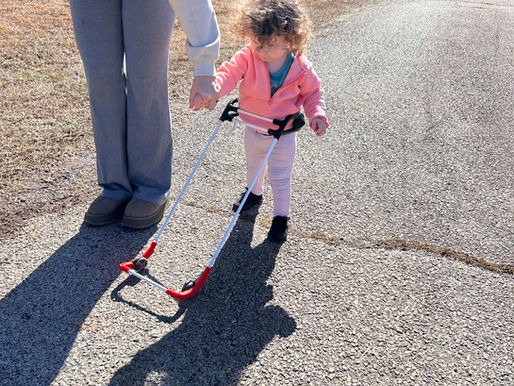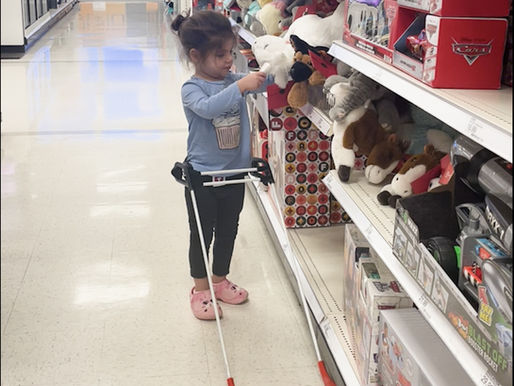top of page
Blog


How a Pediatric Mobility Cane Enhances Independence and Safety
Mobility challenges can feel daunting, but with the right tools and support, children can thrive. The Pediatric Belt Cane is more than a device - it’s a key to unlocking a world of possibilities. So, why wait? Explore options, seek professional advice, and watch your child take confident strides toward independence.

Grace Ambrose-Zaken
2 days ago


Empowering Mobility with Pediatric Mobility Aids: A Guide to Belt Canes and More
When a child faces challenges with vision, mobility becomes a crucial part of their independence and confidence. Pediatric mobility aids are designed to support children in navigating their world safely and effectively. These tools are not just devices; they are bridges to freedom, exploration, and self-reliance. Today, I want to share insights about one such essential aid and the broader landscape of pediatric mobility aids that empower young lives.

Grace Ambrose-Zaken
5 days ago


Why Pediatric Belt Canes Improve Mobility: A Guide to Pediatric Mobility Aids
When it comes to helping children with visual impairments navigate the world safely and confidently, the right tools make all the difference. Pediatric mobility aids are designed specifically to meet the unique needs of young users. Among these aids, one stands out for its practicality and effectiveness: the pediatric belt cane. This tool is more than just a cane; it’s a bridge to independence, safety, and confidence for children learning to move through their environment.

Grace Ambrose-Zaken
Dec 1


Thankful for Pediatric Belt Canes Supporting Early Mobility
Mobility tools for children with visual impairments or blindness are tailored to their unique needs. Unlike adult devices, pediatric tools consider size, weight, and the developmental stage of the child. The Pediatric Belt Cane is a perfect example. It’s lightweight, easy to handle, and designed for children.

Grace Ambrose-Zaken
Nov 28


The Benefits of Pediatric Belt Canes
Safety is paramount when it comes to overseeing the education and play of young children. The Pediatric Belt Cane plays a crucial role in reducing risks associated with immature cane handling. When a cane is dropped or misplaced, the child may be vulnerable to tripping or losing orientation. The belt eliminates these hazards by keeping the cane firmly attached.

Grace Ambrose-Zaken
Nov 24


Join Us Tomorrow for Celebrating Innovation Pediatric Belt Canes for children with deafblindness
This event will provide an in-depth look at the Pediatric Belt Cane and its role in supporting DeafBlind toddlers. Attendees will hear from Dr. Grace Ambrose-Zaken the renown inventor of the belt cane and expert in orientation and mobility, learn about the research outcomes of the belt cane, and see real-life video examples of how it improves motor and developmental outcomes in children with deafblindness.
Beaux Jettson
Nov 17


Listen Today to Creating an Easier-to-Navigate World for Children
In the latest episode of the Ophthalmology Innovation Summit (OIS) Podcast, Creating an Easier-to-Navigate World for Children, Safe Toddles President and CEO Grace Ambrose-Zaken, Ph.D., joins host Robert Rothman to discuss her groundbreaking work developing the Pediatric Belt Cane—a first-of-its-kind mobility device that’s changing what’s possible for blind and visually impaired children.
Beaux Jettson
Nov 12


Exciting Progress: Our Transition to Durable Injection Molded Parts for Pediatric Belt Canes
Safe Toddles announces a major milestone: transitioning from 3D-printed to injection molded plastic parts for the Pediatric Belt Cane. This advancement means stronger, heat-resistant, and more durable components, helping children who are blind or visually impaired move safely and confidently.
Beaux Jettson
Nov 11


Your Blind Child Isn’t being “Bad” — The Cane Is Too Difficult to Swing Each Step
If your blind child resists using their cane, it’s not defiance — it’s design. Many young children struggle to swing a traditional long cane safely or effectively. Learn the five signs your blind child’s cane or mobility device isn’t right and discover how the Pediatric Belt Cane can help them walk confidently, safely, and independently.

Grace Ambrose-Zaken
Nov 4


Enhancing Mobility for Visually Impaired Children with Belt Canes
Mobility tools for vision impaired children are designed to help them detect obstacles, understand their environment, and move safely. These tools range from traditional long canes to more innovative devices like the belt cane. Each tool has its unique benefits and applications.

Grace Ambrose-Zaken
Nov 3


Unlocking the Mystery: How White Canes Work
When vision can’t guide a child, touch can. The white cane extends that touch, offering safety, awareness, and freedom of movement. Discover how the Belt Cane adapts this essential mobility tool for the youngest learners.

Grace Ambrose-Zaken
Oct 17


🌟 White Cane Day Has New Meaning for the Youngest Explorers
White Cane Day has new meaning for children who are blind from birth. With the Pediatric Belt Cane and Rectangular AMD, even toddlers can now join the celebration — walking safely and independently using touch for balance, protection, and exploration.

Grace Ambrose-Zaken
Oct 13


The William G. and Helen C. Hoffman Foundation Renews Support for Safe Toddles with a $30,000 Grant to Advance Early Mobility for Blind Children
Safe Toddles receives a $30,000 grant from the William G. and Helen C. Hoffman Foundation—their second year of support—to expand early mobility access for blind children through Pediatric Belt Canes, training, and family outreach.
Beaux Jettson
Oct 10


Empowering Independence: Chores for Children with Visual Impairments
Now that your blind child is moving confidently with the Pediatric Belt Cane, it’s the perfect time to start building independence at home. Learn how to teach age-appropriate chores through direct instruction, tactile routines, and daily practice—empowering your child to develop essential life skills one step at a time.

Grace Ambrose-Zaken
Sep 22
bottom of page




